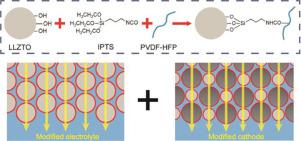Energy Storage Materials ( IF 18.9 ) Pub Date : 2022-06-16 , DOI: 10.1016/j.ensm.2022.06.025 Zhouyu Zhang , Shu Zhang , Shouxian Geng , Shoubin Zhou , Zhenglin Hu , Jiayan Luo

|
Polymer composite electrolytes are receiving ever-increasing attention due to the favorable safety and flexibility, while inferior organic/inorganic interphase compatibility inevitably leads to serious agglomeration of ceramic particles and severely blocked Li+ transport in bulky electrolytes, especially for “polymer-in-ceramic” (PIC) systems with ultrahigh ceramic content. Herein, a silane coupling agent 3-Isocyanatopropyltriethoxysilane (IPTS) is introduced into PIC electrolyte to build bridge model at organic/inorganic interphase. Via in-situ coupling reaction, conventional weak physical contact between organic/inorganic components has been successfully transformed into stronger chemical interaction, resulting in homogeneous ceramic dispersion, enhanced Li+ conductivity (0.6 mS cm−1 at room temperature) and transference number (0.87) with broadened electrochemical window (5.2 V vs. Li+/Li). Moreover, the in-situ built bridge model can also be applied into various cathodes. Notably, the IPTS modified LiCoO2 (SLCO) and LiNi0.8Co0.15Al0.05O2 (SNCA) deliver uniform morphology and enhanced Li+ apparent diffusion coefficient. In this case, both all-solid-state symmetric and full cells exhibit prolonged cycling life at wide operation temperature. This work provides a universal strategy to optimize the long-ignored tough issues around the interphase for both composite electrolytes and cathodes, also enlightening other composite systems to overcome their intrinsic incompatibility.
中文翻译:

用于全固态锂金属电池的无团聚复合固体电解质和增强的阴极-电解质界面动力学
聚合物复合电解质因其良好的安全性和柔韧性而受到越来越多的关注,而较差的有机/无机相间相容性不可避免地导致陶瓷颗粒严重团聚,严重阻碍锂离子在大体积电解质中的传输,尤其是对于“陶瓷中聚合物” ” (PIC) 系统具有超高陶瓷含量。在此,将硅烷偶联剂 3-异氰酸丙基三乙氧基硅烷 (IPTS) 引入 PIC 电解液中,在有机/无机界面处建立桥模型。通过原位偶联反应,有机/无机组分之间传统的弱物理接触已成功转化为更强的化学相互作用,导致陶瓷分散均匀,Li +电导率提高(0.6 mS cm室温下为-1 )和转移数(0.87),电化学窗口加宽(5.2 V vs. Li + /Li)。此外,原位建桥模型还可以应用于各种阴极。值得注意的是,IPTS 改性的 LiCoO 2 (SLCO) 和 LiNi 0.8 Co 0.15 Al 0.05 O 2 (SNCA) 提供了均匀的形态和增强的 Li +表观扩散系数。在这种情况下,全固态对称电池和全电池在宽工作温度下都表现出延长的循环寿命。这项工作提供了一种通用策略来优化复合电解质和阴极界面周围长期被忽视的棘手问题,也启发了其他复合系统克服其固有的不相容性。










































 京公网安备 11010802027423号
京公网安备 11010802027423号